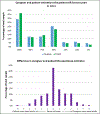How much time is left? Associations between estimations of patient life expectancy and quality of life in patients and caregivers
- PMID: 30387051
- PMCID: PMC6494724
- DOI: 10.1007/s00520-018-4533-2
How much time is left? Associations between estimations of patient life expectancy and quality of life in patients and caregivers
Abstract
Purpose: It is unclear whether life-expectancy estimates of patients with advanced cancer and their caregivers are associated with patient existential, social, or emotional quality of life (QOL) or caregiver emotional QOL.
Methods: Patients with advanced cancer and their caregivers (n = 162 dyads) reported estimates of the chance the patient would live for 2 years or more from 0% (most pessimistic) to 100% (most optimistic). They also completed self-report measures of QOL.
Results: Adjusting for sociodemographic confounds and multiple comparisons, more pessimistic caregiver and patient life-expectancy estimates were associated with worse caregiver emotional QOL and worse patient existential QOL. Discrepancies between patient and caregiver estimates were not associated with patient or caregiver QOL.
Conclusions: Pessimistic life-expectancy estimates are associated with worse existential QOL in patients and worse emotional QOL in caregivers. Prospective research to establish causal relationships is needed, and interventions to address the relationship between beliefs about life expectancy and existential and emotional QOL should be considered. Providing these interventions to patients and caregivers receiving information on life expectancy may mitigate the negative impact of life-expectancy information on patient existential quality of life.
Keywords: Cancer; Caregiving; Life-expectancy estimate; Oncology; Quality of life.
Conflict of interest statement
CONFLICT OF INTEREST
The authors have no conflicts of interest to report
Figures
References
-
- Institute of Medicine of the National Academies (2008) Cancer care for the whole patient: Meeting psychosocial health needs Washington, DC: The National Academies Press. - PubMed
-
- Lechelt LA, et al. (2018) Top 10 research priorities in head and neck cancer: Results of an Alberta priority setting partnership of patients, caregivers, family members, and clinicians. Head Neck 40: 544–554. - PubMed
-
- Soni MK and Cella D. (2002) Quality of life and symptom measures in oncology: An overview. The American journal of managed care 8: S560–73. - PubMed
MeSH terms
Grants and funding
LinkOut - more resources
Full Text Sources
Medical



